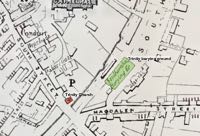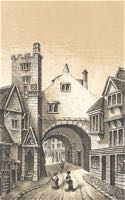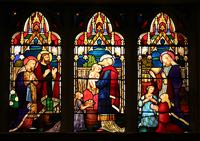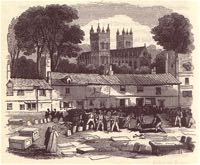
Holy Trinity Church - South Street
Page updated 2nd November 2015
 No longer a church, Holy Trinity occupies a site, just inside the old South Gate, that has had an ecclesiastical presence since medieval times.
No longer a church, Holy Trinity occupies a site, just inside the old South Gate, that has had an ecclesiastical presence since medieval times.
A church of St James was in existence near Holy Trinity in 1222. Hoskins surmises that it was absorbed into Holy Trinity at the time of the Black Death. Certainly by 1387 there was a reference to “the waste place where the church of St James formerly stood”. The church tower was right next to the road as it passed through the arched priest’s house, and then the separate South Gate. In 1853, William Harding refers to the priest’s house which was built on the inner side of the South Gate, over the road. Harding quotes a document dated 18 May 1615 which states, "mentions also the Parsonage House, which was built over the king's high way; the entrance to which was by a Gothic door, forming an inconvenient projection into the street". The church was remodelled in the early 15th Century, when the South Gate was rebuilt.
In 1656, an ordinance of Parliament was passed that "for the better promoting and preaching of the Gospel”, that all but four of Exeter's churches were to be closed. The rest would be sold as schools, burying places and other uses. Many parishioners objected and purchased their churches back. Holy Trinity was sold back to the parishioners, on the 19th June 1656 for £100.
The old Holy Trinity Church was demolished in 1819 when the South Gate and the priest’s house was removed.
There was a small cemetery to the rear of the church, but by the 17th Century it was no longer adequate for the needs of the population. In 1664, Trinity Green, a new, and larger cemetery was consecrated, just outside the Southgate. The rest of Southernhay was planted with 200 elms in the same year. Trinity Green was the site of rioting during the 1832 cholera outbreak, as locals objected to cholera burials.
The new Holy Trinity
The present Holy Trinity was built in 1820 at a cost of £7,295; it was set back from the road, to allow a much wider carriage way than previously. In a time of extensive church building, the new church was not constructed to a high standard to save money. The architect was Robert Cornish who produced a simple gothic style, with a castellated top, that according to White's Devonshire Directory, in 1850 "has about 1000 sittings, of which nearly 100 are free". The turret contains a clock and bell cast by Mears in 1820, especially for the church.
Edith Cresswell was not impressed with the design and described the new church thus.
The west front combines a classic pediment with gothic crocketed pinnacles and above this is a bell turret; only from the back can its remarkable elongated shape be seen to full advantage. It seems not quite sure whether it was intended for a tower or a chimney, and has stopped at something half way between the two. As the church stands back a good bit from the road other architectural deformities in front retire behind railings, small trees, and the shop fronts. The rectangular nave can hardly be called a nave. Down this are four bays, with clustered columns, which seem not so much to form aisles as to support the galleries on each side of the church, also crossing the west end above a stone screen that divides the entrance from the interior of the church.
The stained east window was a memorial to Richard Durant and his wife. In 1884, the church was reseated at a cost of £900, and a new pulpit and prayer desk of carved oak were installed. The register dates from 1605 for the previous St James' Church and George's.
Trinity closes
The parish was united with St Leonard's in 1969, and Trinity was deconsecrated and closed. It lay empty, becoming derelict, until 1977, when a road widening scheme condemned it. The scheme was modified, saving the church–the City Council offered the lease to anyone who could make use of it. The White Ensign Club, which had previously met in various pubs around the city, signed a 50 lease on the 23 May 1979, and proceeded to convert the building into a club house. The new club premises was officially opened on 8 December 1980 by Flag Officer Plymouth, Vice Admiral Sir Peter Berger KCB, MVO, DSC along with the Right Worshipful Mayor of Exeter, Councillor Mrs J.M. Richardson
The club has a large number of naval memorabilia, including flags, pennants, photographs, ship’s bells and a large model of the York Class HMS Exeter. A glass cabinet contains artifacts used by survivors of the Exeter, who were interned by the Japanese at the Makassar POW camp, and for which the Club are the custodians on behalf of the City.
Source: White's 1850, Kelly's 1897, White ensign Club, Edith Cresswell's Exeter Churches.
│ Top of Page │



